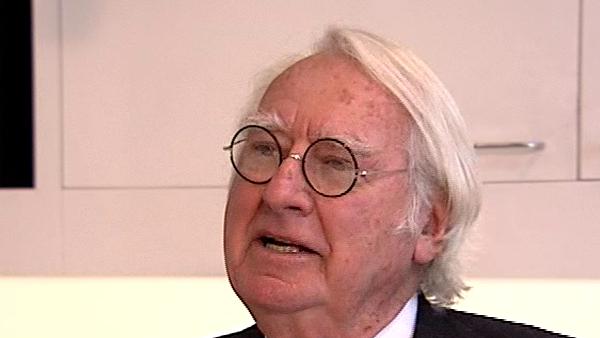NEXT STORY

Westbeth Artists' Housing
RELATED STORIES

NEXT STORY

Westbeth Artists' Housing
RELATED STORIES


|
Views | Duration | |
|---|---|---|---|
| 1. 'I'm going to be an architect' | 763 | 02:07 | |
| 2. Why Cornell? | 341 | 01:56 | |
| 3. My contemporaries at Cornell | 1 | 296 | 01:35 |
| 4. Meeting Le Corbusier | 531 | 04:10 | |
| 5. A beach house in Fire Island | 453 | 01:56 | |
| 6. Westbeth Artists' Housing | 343 | 01:57 | |
| 7. The Bronx Developmental Center | 284 | 01:25 | |
| 8. The Smith House | 545 | 03:06 | |
| 9. Photographing architecture is more than art | 276 | 02:21 | |
| 10. My small-scale work influenced my large-scale projects | 261 | 01:06 |

I had one table, a big table and at first, I worked alone and I did a beach house in Fire Island. That's where some people from Princeton, who were... he was teaching at Princeton. They said, we have $9000, we bought this site right on the ocean. Well, even then $9000 wasn't very much, but we built the beach house in nine days for $9000. And the way we were able to do that was I was reading the New York Times magazine section and, you know, the advertisements in the back of the magazine section and there was a company in Michigan that made pre-cut log cabins. You would, you know, say, I want my log cabin ten by ten, whatever it is. They'd cut the material, they'd ship it by boat, and put up the log cabin. So I said well, if you could do that with a log cabin, you can do that with a real contemporary building. So I said, look, here's a design and they cut the lumber three by six, three inches thick, so it's an inside finish and an outside finish, no insulation and we built the house out of that pre-cut lumber, sleeping on the beach, in nine days.
[Q] Right.
So that was published actually in the New York Times magazine section after it was finished. My parents felt, well, you know, if it's okay for the New York Times maybe we could have our son build a house for that. And so I then I did the house for my parents in Essex Fells. They had been living in a three-storey house and they didn't want to walk up and down stairs anymore and they wanted to live in a ranch, what they call a ranch house, one level. So I made the one level house for them in Essex Fells.
The prominent American architect Richard Meier (b. 1934) is best known for the Getty Centre in Los Angeles, one of his many public projects which broke from his usual style of sleek, white buildings. In all his work – carried out with characteristic refined style – he refuses to bend to the trends of modern architecture. He has won many awards including the Pritzker Prize for Architecture, considered the field's highest honour.
Title: A beach house in Fire Island
Listeners: Massimo Vignelli
Massimo Vignelli was born in Milan and studied architecture in Milan and Venice. He is the co-founder and President of Vignelli Associates and Chief Executive Officer of Vignelli Designs in New York. His work includes graphic and corporate identity programs, publication designs, architectural graphics, interiors, furniture, and consumer product designs. His work has been published and exhibited throughout the world and entered in the permanent collections of several museums. He has taught and lectured on design in the major cities and universities in the United States and abroad. Included among Massimo Vignelli's awards are the Gran Premio Triennale di Milano, 1964, the Compasso d'Oro, awarded by the Italian Association for Industrial Design (ADI), 1964 and 1998, the 1982 Art Directors Club Hall of Fame, the 1983 AIGA Gold Medal, the 1992 Interior Product Designers Fellowship of Excellence, The 1995 Brooklyn Museum Design Award for Lifetime Achievement and The 2001 Russel Wright Award for Design Excellence.
Tags: Fire Island, Essex Fells
Duration: 1 minute, 56 seconds
Date story recorded: March 2007
Date story went live: 23 December 2008